The robot aircraft with a nightmarish nuclear mission
 Getty Images
Getty ImagesThe atomic bomb tests at Bikini Atoll in 1946 were too dangerous for conventional aircraft to observe. Pioneering remote-controlled drones, however, were a perfect match.
The newsreel whirls into action. "OPERATION CROSSROADS… UNDERWATER BLAST AGAIN ROCKS BIKINI ATOLL…" A site which makes history for the motion picture camera.
It is impossible to take your eyes away from the monstrous beauty and obscenity of the nuclear weapon explosion – only the fifth in the history of humanity. Or the sight of target warships shrunk to the size of toys by the vastness of the mushroom cloud, disappearing into the furious white depths of the sea.
In July 1946, the United States exploded two nuclear bombs at Bikini Atoll in what was called Operation Crossroads. The first was exploded in the air, the second under water – and the stakes were high. These were the first tests of nuclear weapons since the Manhattan Project's Trinity test in July 1945, and the first detonations since the destruction of Nagasaki the following month – and they involved a task force of more than 42,000 personnel, 250 ships and 150 aircraft, to set up, run, observe, record and analyse the tests.
But how do you observe a nuclear test when the blast and radiation are so hazardous to humans? You use drones.
The newsreel mentioned above cut to a shot of a single-engine fighter aircraft flying through the radioactive mushroom cloud, but it was no ordinary aircraft. It was a pilotless plane, and it wasn't the only one deployed during the tests.
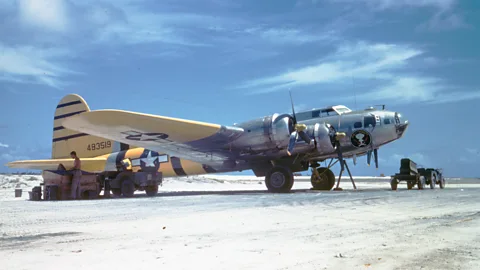 National Archives and Records Administration
National Archives and Records AdministrationOff camera were a fleet of pilotless Grumman Hellcats and Boeing B-17 Flying Fortresses. These warplanes, fresh off the production line at the end of World War Two, had been "droned" by the addition of a set of radio-controlled instruments, and, certainly in the B-17s, television cameras as well, to allow a pilot to fly the plane from a "control" aircraft nearby or a truck on the ground.
Bombs and guns were replaced by instruments such as air scoops and collection bags, filter boxes, Geiger counters, radio controlled cameras, telemeters and electronic recording instruments, to measure the radioactivity in the mushroom cloud and the effect of the blast on the plane itself.
For their first public test the pilotless aircraft had to make the most dangerous flight of all. They had to fly through the mushroom cloud.
Scientist Nikola Tesla and science fiction pioneer HG Wells conceived of radio-controlled flying weapons before World War One. In 1917, this vision came one step closer to reality when Britain flew the first pilotless aircraft. Named the the "Aerial Target", it was a rather insect-like experimental radio-controlled monoplane designed by planemaker de Havilland. Not to be outdone, the Americans tested an aerial torpedo called the Kettering Bug the following year. The biplane-like contraption used a gyroscope to fly into targets up to 75 miles (121 km) away.
By 1899–1900, there's already discussions about the idea that an aircraft could be guided by radio and turned into a weapon," says Roger Connor, curator at the Aeronautics Department, Smithsonian’s National Air and Space Museum. "And in World War I, pretty much all the warring powers are investing in attempts to do this."
Neither the Aerial Target nor the Kettering Bug saw service in WWI, but this didn't stop the development of the technology. On 15 September 1924, for the first time in US history a remote-controlled aircraft took-off, was put through maneuvres and landed safely without a human pilot on board. Eleven years later, the British flew the DH.82B Queen Bee based on the Tiger Moth training plane using remote control. It was essentially a Tiger Moth without the pilot. More than 400 of these machines were made by 1943.
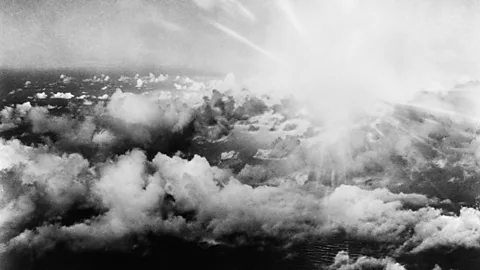 Getty Images
Getty ImagesInspired by the British success, the United States Army Air Force (USAAF) and US Navy both developed target drones: the air force used smaller machines, the navy, obsolete Boeing biplane fighters. In World War II, they extended the idea to large, multi-engined bombers. In World War II, they extended the idea to large, multi-engined bombers, and small “attack” drones.
At the start of these programmes, a human pilot had to fly these lumbering machines off the runway, and then parachute out. By the end, a pilot could perform the whole operation remotely. The small, purpose-built drones were able to drop a bomb or a torpedo on a target 425 mi (684 km) away – and saw some action against Japan in the Pacific.
You might also like:
"While they weren’t particularly successful as weapons," says Connor, "by the end of the war, when planning for [Operation] Crossroads is taking place it's a fairly easy decision to say okay, these are the platforms that we would use for this purpose."
Although some aspects of Operation Crossroads didn’t go to plan, the drones exceeded their controllers’ expectations.
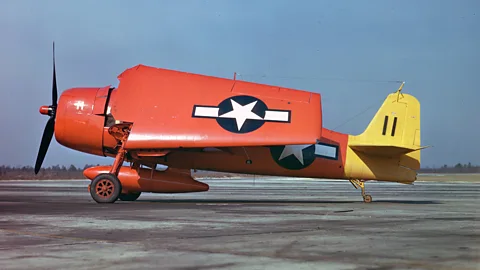 National Archives and Records Administration
National Archives and Records AdministrationIn both tests, the drones flew where humans feared. They passed through the mushroom clouds and over them, east to west, at altitudes from 10,000ft to 28,000ft (3,040 to 8,534m). It was only when the mushroom cloud of the second test didn't rise as high as expected that some of the drones didn't detect any radiation.
The drone fleet performed well during the tests. The Hellcats launched by catapult from an aircraft carrier, and all but one safely made it back to dry land. Its controls failed before the detonation of the bomb. Another, emerged from the mushroom cloud completely white, covered in ice, and a control plane came close to disaster, when the pilot flew too close to the billowing cloud.
It was the first B-17 operation in which all the take-offs, flights and landings took place without pilots, and the drones' missions were achieved without significant incidents. A few doors and windows on the planes blew in – and the brakes of one bomber were damaged in the explosion, forcing it to overrun on its return.
The data they gathered about the nature of the mushroom cloud by measuring radiation levels, collecting air samples, and taking synchronised pictures by radio command furthered scientific understanding of nuclear explosions – as did the Geiger counters readings of the radioactivity on the aircraft themselves when they had landed.
"The tests marked the first time that drones were used in a significant way for data gathering," says Connor. "The drones could go where no human-crewed aircraft could. There was simply no other viable option for the type of sampling done by these drones. This established the Cold War paradigm of using drones for missions that were too 'dull, dirty, or dangerous' for other aircraft."
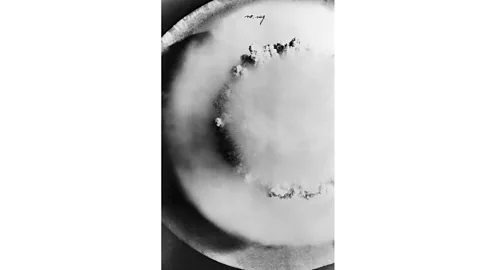 Getty Images
Getty ImagesA fortnight later, two of the Boeing B-17 drones went on to set the record for the longest unmanned flight with a 2,174-mile (3,500-km) journey from Hawaii to California.
The New York Times rather prematurely proclaimed that drones "will soon be a familiar sight in the skyways of the world as rehearsals begin for 'push-button war' in the air…
"Fleets of drones controlled by 'mother' ships – all of them carrying bombs – could probably saturate the air defences of any city in the world.
Yet the role of these early drones has largely been forgotten. "I think this is a simple case of availability bias," says Sarah Kreps, John L Wetherill Professor, Cornell University, and Director, Cornell Tech Policy Institute. "We have recency with Predators and Reapers [drone types used today] so it can be easy to assume that time started with these and to discount the ancestors of these technologies."
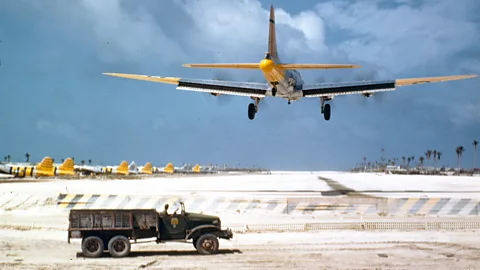 National Archives and Records Administration
National Archives and Records AdministrationBut this "push-button" future was still a way off in 1946. A drone squadron of converted wartime aircraft continued to be used to monitor American nuclear tests, and as targets for the missiles developed in the 1950s, until they were replaced by faster, droned jet fighters. During the Korean War, pilotless Hellcats packed with explosives tried to hit targets that would have been suicidal for crewed aircraft, with limited success. Drones then went on to be widely used in the Vietnam War.
"Some estimates suggest that the use of B-17s in Bikini Atoll accelerated the developments of drones by at least a year," says Kreps. "I would see the experiences with atomic drones as just another data point in the long, but punctuated evolution of drones over the last century or more."
There was another legacy of these atomic drones. "They've always tended to work in the shadows, validating new weapons systems, or operating in reconnaissance in areas that are too difficult for other aircraft to operate in," says Connor. "All of those are things still don't get talked about... and deliberately so."
--
